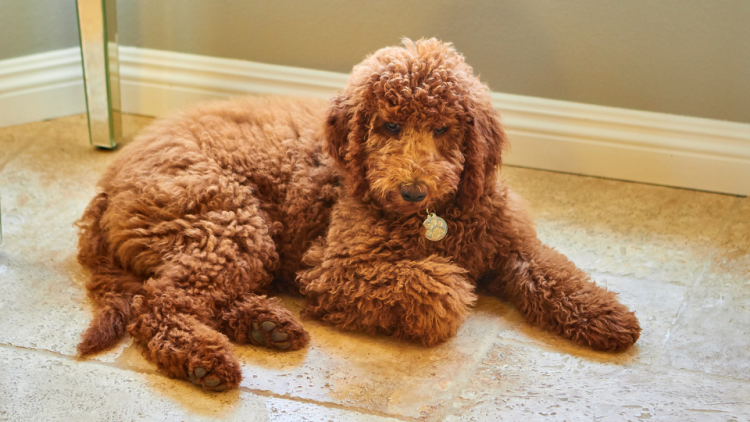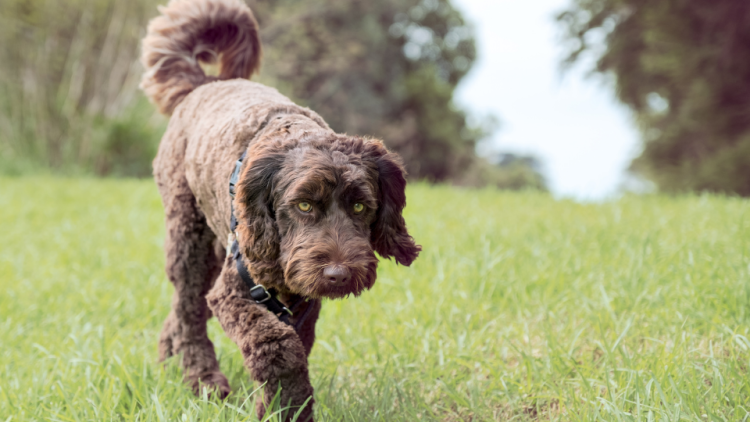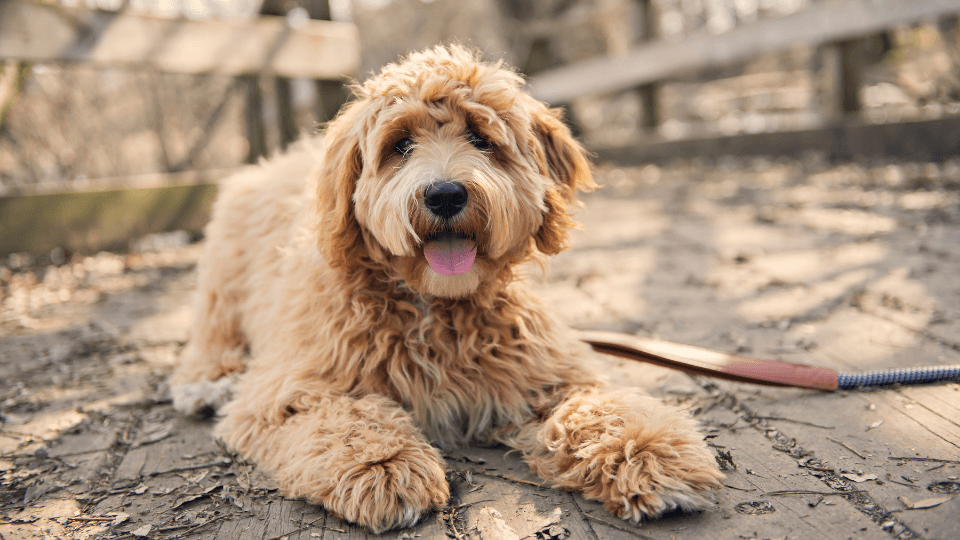Initially developed in Australia as a guide dog for a blind woman whose husband had dog hair allergies, the Labradoodle breed is a clever dog breed with a low to non-shedding coat. A Labradoodle is a hybrid dog breed with a purebred Poodle parent and a purebred Labrador Retriever parent. They’re athletic, yet graceful, in appearance and have compact bodies with manageable coats that come in a wide range of colors - from apricot to silver, chocolate, and more. An intuitive, easy-to-train nature makes them a fantastic dog breed for many families.
If you’re the lucky pet parent to one of these pups, you may be wondering how big will my Labradoodle puppy get and when will they stop growing? Our Labradoodle growth chart will show you what weight you can expect at each stage in their development. Here’s everything you need to know about Labradoodle puppy growth:
- Labradoodle Growth & Weight Chart
- How does the Labradoodle growth chart work?
- At what age is a Labradoodle fully grown?
- How big should a 6-month-old Labradoodle be?
- How much bigger will my Labradoodle get?
- What is the size of a full-grown Labradoodle?
- How do I make sure my Labradoodle is healthy?
Pro Tip: Want to be reimbursed for up to 90% of your dog’s veterinary bills whenever they are sick or injured? Compare Labradoodle dog insurance options to save money on healthcare costs throughout your pup’s life.
Labradoodle Growth & Weight Chart
| Age | Weight |
|---|---|
| 1 month old | 3 - 5 lbs |
| 2 months old | 5 - 15 lbs |
| 3 months old | 20 - 25 lbs |
| 4 months old | 25 - 35 lbs |
| 5 months old | 35 - 50 lbs |
| 6 months old | 40 - 55 lbs |
| 7 months old | 45 - 60 lbs |
| 8 months old | 50 - 65 lbs |
| 9 months old | 50 - 70 lbs |
| 10 months old | 50 - 75 lbs |
| 11 months old | 50 - 75 lbs |
| 12 months old | 50 - 80 lbs |
| 2 years old | 50 - 90 lbs |
Note: Labradoodles are not an official American Kennel Club breed and are not recognized by any other major kennel club as of this publication in April 2021. Due to the lack of an official breed standard, a Labradoodle’s adult weight can vary significantly based on their parents’ size.
How does the Labradoodle growth chart work?
The following numbers are estimates based on the litter of a Labrador Retriever crossed with a standard Poodle. If your pup's Poodle parent is a toy size, then they are likely to be significantly smaller than these estimates. There are also Labradoodles that are not an exact 50/50 crossbreed. If your puppy's genetic makeup is only 25% Lab and 75% Poodle, for example, their weight at maturity may be much lighter than 50 pounds.
If you know your puppy’s parents’ exact weight, you can try adding their two weights together and dividing by two for a rough average of how big the puppy will weigh as an adult. Please use the Labradoodle weight chart as an estimate, and don’t worry if your puppy is behind or ahead of the pack. Their health is what matters most, so if you have questions or concerns about your puppy's development, reach out to your veterinarian.
At what age is a Labradoodle fully grown?
Labradoodles typically need 12 to 18 months to reach their full size, especially if their parents were on the heavier side of the average weight spectrum. Large breeds grow slower and take longer to reach their full size compared to small and medium-sized dog breeds, which usually reach maturity within nine to 11 months.

How big should a 6-month-old Labradoodle be?
A 6-month-old Labradoodle may weigh anywhere between 40 and 55 pounds. As a general rule, male Labradoodles weigh more than their female counterparts.
In terms of height, a 6-month-old Labradoodle puppy will stand around 14 to 18 inches tall at the shoulders, but this varies based on their genetic makeup.
Pro Tip: Download our new puppy checklist for tips on how to set up a vaccination schedule, essential pet care supplies, and more.
How much bigger will my Labradoodle get?
There are a few ways you can estimate how much more your Labradoodle may grow.
- Age. Most Labradoodles need anywhere from 12 to 18 months to reach their full size. If your pup is younger than a year old, they are likely still growing. Refer to our Labradoodle weight chart to estimate how many more pounds they might put on as they mature into adulthood.
- Paws. You can also take a look at your puppy’s paws. If they look oversized compared to their limbs, then they're probably still filling out. Oversized paws are a classic puppy feature indicating that your pup still has more growth underway.
- Breeder. Lastly, if you purchased your puppy from a breeder, you can contact them about your Labradoodle's weight. Alhough the breed varies greatly in size, knowing the weight of your puppy's parents (and those of previous litters) can help you predict your Labradoodle's adult size. Simply add their parents’ weights together and divide by two for a rough estimate of your puppy’s full-grown size.
What is the size of a full-grown Labradoodle?
As a hybrid dog breed, Labradoodles vary significantly in size based on their geneology. Per Agape Labradoodles, adult Labradoodles typically weigh over 45 pounds, with some Labradoodles weighing as much as 100 pounds. However, most Labradoodles will weigh between 50 and 90 pounds.
In [terms of height], Labradoodles stand 21 to 24 inches tall when measured from paw to shoulder, or approximately two feet excluding their neck and crown of the head.
How do I make sure my Labradoodle is healthy?
Our Labradoodle puppies are important, cherished family members who we want the best for. One of the best ways to help your Labradoodle thrive is by taking them to regular veterinary appointments to have them routinely checked out and evaluated. Prevention is always better than treatment, and regular veterinary exams provide your veterinarian with the opportunity to screen your Labradoodle for disease. Your puppy will need to see the veterinarian several times in their first six months of life for core vaccinations against things like Rabies, and then at least once a year as an adult for annual health check-ups.

As the offspring of two purebred dog breeds, Labradoodles are at a heightened risk of many genetic conditions, including Addison’s disease, hypothyroidism, and eye disorders. Like their parents, Labradoodles are also more susceptible to hip dysplasia, a common orthopedic condition that occurs when the hip joint forms improperly. Hip dysplasia can lead to pain in their back legs, impaired mobility, and even lameness if not treated - fortunately, the condition is treatable with surgery.
Labradoodle Veterinary Expenses
Depending on the severity of the hip dysplasia, surgery can cost anywhere from $1200 to $7000 per hip. If both of your dog’s hips are affected, and they need complete hip replacements, surgery can cost up to $14,000. Post-surgery, your Labradoodle may continue needing prescription medication for pain and physical therapy, which can add up to thousands of dollars over your dog’s lifetime.
When over 20,000 pet parents were surveyed, only 19.8% said they would be able to pay for a $5,000 veterinary expense out-of-pocket. As loving pet parents, it can be devastating to think that our four-legged friend could develop a painful disease that requires expensive treatment. This is where pet insurance comes in.
Pet insurance works by reimbursing you for up to 90% of out-of-pocket veterinary costs should your pet fall ill or have an accident. Most pet parents opt for accident and illness pet insurance plans as they cover both injuries and most illnesses, such as hip dysplasia or eye diseases. Pet wellness plans can be added to your insurance coverage to help you pay for preventive veterinary care, like your regular vet exams, x-rays, dental cleanings, vaccinations, and more.
Like humans, dogs are living longer, which creates an even bigger need for excellent veterinary care so that our dogs can live their happiest and healthiest lives. Pet insurance helps alleviate the financial strain that's often caused by vet visit costs. Financial constraints shouldn’t dictate the medical care your loved one receives, and pet insurance provides peace of mind by ensuring they’ll receive access to gold-standard care should any health concern ever arise. If your Labradoodle puppy gets sick or hurt, you and your veterinarian can work together to provide your pup with the best treatment plan - without worrying about how much it might cost.
Key Takeaways
- Adult Labradoodles weigh 50-90 pounds on average.
- The parent Poodle breed has toy and standard size variations that impact the size of the offspring, along with other genetic factors.
- Most Labradoodles grow until 12-18 months of age.
- The breed is known for several congenital health disorders, and is especially prone to hip dysplasia.
- Pet insurance can protect your puppy and provide a financial safety net for vet costs throughout their life.
